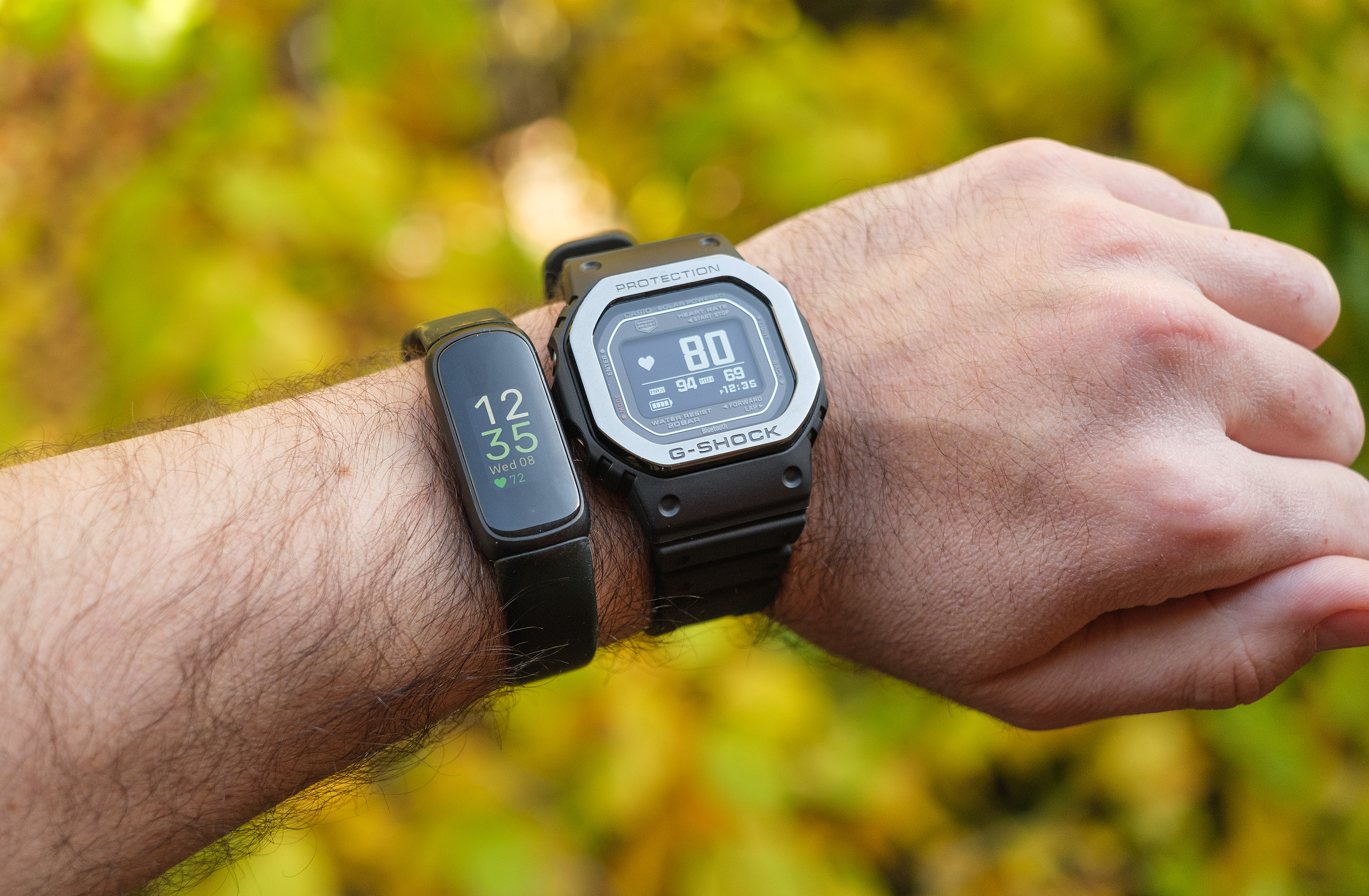
We love pitting fitness wearables against one another. Whether it’s the Apple Watch 9 against the Apple Watch 8 or the latest Fitbit Charge versus the newest Fitbit Inspire, finding out which trackers are most accurate is kind of our obsession here at Tom’s Guide.
With this in mind, I walked 3,000 steps with the Fitbit Inspire 3 and G-Shock Move DWH5600 strapped to my wrists. Which tracked my steps more accurately? Read on.
Before the big reveal, it’s worth touching on some key design differences between these two popular models. The Inspire 3 is Fitbit’s most entry-level, budget-friendly option. Priced at $100, it has a slim, low-key design centered around a 0.7-inch AMOLED color touchscreen.
The Casio G-Shock Move, on the other hand, is a $300 fashion-forward smartwatch packed with fitness features. It looks just like a classic digital Casio from the 1980s, which I find charming, complete with a B&W LCD. Unlike the Inspire 3, this watch is meant to be shown off.
Design differences aside, both models offer many of the same workout tracking features. Neither has an onboard GPS, so steps are calculated through a combination of accelerometer data and GPS data from a paired device, if available. Both models also monitor heart rate and use that data to determine how strenuous your workout was. You also get an estimation of how many calories you burned, average bpm and more.
I walked 3,000 steps with the Fitbit Inspire 3 and G-Shock Move — here's which was most accurate
To complete my test, I wore the G-Shock on my left wrist and Fitbit on my right. Neither device was paired with my iPhone’s GPS during the walk. Steps were counted manually, and I also ran Strava on my phone, which uses the GPS signal, as a secondary control.
So which wearable came out on top? It may come as a surprise, but the G-shock Move calculated my steps more accurately than either the Fitbit Inspire 3 or Strava. While no fitness tracker or app is going to give a 100% accurate result, the G-Shock was within 15 steps of the actual number, which is impressive.
The results
For what it’s worth, all three methods of tracking were within 100 steps of my 3,000-step count. That said, I’m a little surprised that Strava was the least accurate of the bunch. I really thought access to GPS data would give it an edge.
It’s worth noting that both the Strava and the Fitbit apps provide a final tally of the number of steps taken when you complete a walk. The Casio Watches app, on the other hand, does not. Instead, you get a total step count for the day but for some reason, no step count for the individual activities you've tracked.
I’m not sure if this is an omission on the part of G-Shock— I’m running up-to-date firmware — but it is frustrating. For some clarity, I’ve reached out to Casio to make sure I’m not overlooking some sort of hidden setting. And I will update this story when I learn more.

Fortunately, the G-Shock app does share your average stride as well as total distance walked. Using these figures, I was able to calculate my steps taken by simply dividing 5,280 (the number of feet in a mile) by my average recorded stride distance, which was 2.3 feet for this walk (Note: not 2 feet 3 inches). This gave me my average number of steps per mile (2,296) which I multiplied by the recorded distance covered (1.3 miles) to get my total steps taken (2,985).
If that is a bit too much math for your taste, I feel your pain. No human being should have to divide numbers, let alone know how many feet are in a mile, to figure out their total step count for a short walk. In that regard, while the G-Shock was more accurate than the Fitbit, I’d likely recommend the latter because the data is easier to access. (The G-Shock app is a bit clunky to navigate overall).
Fitbit Inspire 3 vs. G-Shock Move — other metrics compared
Comparing other metrics, the G-shock said I burned 202 calories during my short walk while the Fitbit placed that number at 263. (it’s impossible to know which number is more accurate.) There was also a fairly notable discrepancy between my average bpm recorded by each. While the Fitbit said I averaged 103 bpm during my walk, the G-Shock recorded 117 bpm (which strikes me as a tad high).
To try and diagnose this difference, I wore the two devices while sitting at my desk to capture my resting heart rate. I also took the same reading using an actual blood pressure monitor. All three came back with 63 bpm, which is reassuring in some ways, but still doesn’t explain the conflicting data from my walk.
Verdict: G-Shock wins the battle, but not the war
Ultimately, the many metrics captured by these devices are just small pieces of data in a much bigger picture. And what makes a fitness tracker useful is not whether each data point is 100% accurate but rather, how the device contextualizes that data in a way that is easy to access and promotes user health and well-being.
So, while the G-shock won the battle of the steps, I’m not convinced it beats the Fitbit in the greater war of the workout devices.







